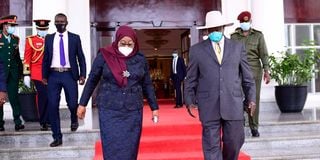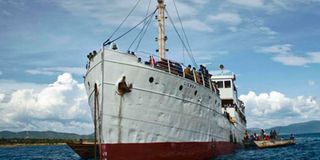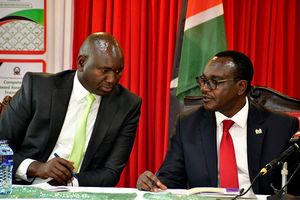Premium
Tanzania, Kenya in fight for lucrative Uganda petroleum trade

A picture taken on May 31, 2021 shows the MV Uhuru, a refurbished cargo ship carrying fuel-loaded wagons, docked at the newly-inaugurated Kisumu port with an oil loading jetty at Lake Victoria in Kisumu, Kenya.
What you need to know:
- The rising political temperatures in Kenya over the Uhuru Kenyatta succession are likely to take a toll on the country’s trade with its East and Central African partners.
The rising political temperatures in Kenya over the Uhuru Kenyatta succession are likely to take a toll on the country’s trade with its East and Central African partners, with importers and transporters on the Northern Corridor already exploring new routes for their cargo.
Just this week, Uganda began a trial delivery of petroleum products from the Dar es Salaam port through Lake Victoria, after a 16-year break. This move spells doom to the Port of Mombasa, which accounts for three-quarters of the transit cargo headed for Uganda.
Uganda, South Sudan, Rwanda, Burundi and the Democratic Republic of Congo (DRC) import a huge percentage of their petroleum products using trucks through Kenya. Refined petroleum, which forms 13 per cent of Kenya’s total exports, is the country’s third-largest export after tea and cut flowers.
Uganda Railways Corporation took 500,000 litres of petroleum products across Lake Victoria from Tanzania. The fuel had landed in Dar es Salaam and was transported by train to the Mwanza port, then to Uganda through the lake.
Now, with Kampala looking to Dar, the potential loss of the lucrative petroleum transshipment business has jolted officials in Nairobi, according to sources. Kenya invested $400 million in the rehabilitation of its oil pipeline network from Mombasa to Eldoret, and holding facilities in Eldoret. It also constructed a $170 million fuel jetty in Kisumu in anticipation of transferring part of the fuel via Lake Victoria.
President Yoweri Museveni shakes hands with Kenya's President Uhuru Kenyatta shortly before their meeting at the State House, Entebbe, on March 11, 2019.
Election effects
While some state officials have put on a brave face, the chipping away of business is likely to increase as the country enters full electioneering mode in the coming months.
The General Election is slated for August 2022 and the battle lines are already drawn.
The falling-out between President Kenyatta and his deputy Dr William Ruto is causing jitters and a bare-knuckle duel is shaping up between the two estranged politicians, who were elected on the same ticket in the elections in 2013 and 2017.
On Thursday, Dr Ruto drew the first blood when his party United Democratic Alliance won its first parliamentary seat in a high-stakes by-election in Kenyatta’s backyard in Kiambu County.
The developments in Kenya have brought back memories of the 2007/08 political crisis after a contested presidential election result when operations in part of the transport corridor stretching from the Mombasa port city to the Great Lakes were paralysed by post-election violence.
Both Mr Kenyatta and Dr Ruto were charged with crimes against humanity at the International Criminal Court in The Hague, but the charges were dropped largely due to lack of evidence and alleged witness tampering.
Transport companies from Uganda and Rwanda were awarded Ksh12.3 billion ($113 million) for losses incurred in the violence. Intraspeed Logistics Ltd, Kampala City Traders Association, Willex Uganda Ltd, KPI Ltd, Katraco Uganda Ltd, Dooba Enterprises, Sebco Uganda, Bunyonyi Safaris, Seven Hills Impex, Uganda Agricultural Tools, Mugenga Holdings, Board City Company and Bidco Uganda Ltd lost vehicles and goods. K
enyan High Court judge Msagha Mbogholi awarded them Ksh6.3 billion ($58 million)as compensation for loss of business and special damages, and another Ksh6 billion ($55 million)as interest on the principal amount. They are yet to be paid by the Kenyan government.
No impact
Kenya Pipeline Corporation managing director Macharia Irungu told The EastAfrican that Uganda’s attempt to re-route shipments through Tanzanian ports of Dar es Salaam and Tanga would not impact its business much, noting that less than three percent of the fuel cargo will go through the Central Corridor.
“We are in a better position as KPC, I am not worried,” Mr Macharia said. “We won’t lose more than three percent of the cargo volume.”
Kenya transports about 900 million litres of petroleum products per month and is banking on Tanzania’s inadequate fuel transport infrastructure to retain the Ugandan petroleum transhipment business.
“Tanzania doesn’t have the infrastructure,” said the KPC boss. “Our route is cheaper and more organised, and they can secure their taxes. Tanzania will not secure their taxes because there are no controls.”
With an inadequate pipeline infrastructure, Tanzania will have to rely on trucks to evacuate the fuel from its port into the shores of Lake Victoria, before it is shipped to Uganda, something Kenya says will be a hard-sell, mostly because of delays and possible adulteration.
“It is expensive to ferry products by road. We normally pump one million litres per hour through the pipeline from Mombasa to Nairobi. When you look at the logistical and operational aspects, it will take Tanzania years to wrest the Ugandan market from us,” Mr Macharia said.
Uganda Railways Corporation (URC) acting managing director Stephen Wakasenza told Bloomberg this week that while they “are comfortable with Mombasa,” they were seeking an alternative route “for strategic reasons”.
“We are targeting oil because it is a product used daily,” he said.

Presidents Samia Suluhu Hassan (Tanzania) and Yoweri Museveni (Uganda) following the former's arrival in Uganda on Sunday, April 11, 2021.
Losing grip
Kenya’s position as the preferred petroleum products importation route for landlocked East and Central African nations started slipping out of its hands in 2015, when EAC countries, save for Uganda, reduced their oil imports from Nairobi due to concerns over adulteration.
Uganda receives over 185 million litres of petroleum products, mostly channelled through the Kisumu port and the Eldoret depot.
“We now aim to use two routes across Lake Victoria from Kenya’s Kisumu port, and Tanzania’s Mwanza port to bring in up to 20 million litres of petroleum products monthly,” Mr Wakasenza said.
The Kisumu port supplies Kampala with up to six million litres of petroleum products monthly, using the MV Uhuru I, and there is a plan is to increase the volume once Kenya completes building its second wagon ferry MV Uhuru II.
In the five months to May, Kenya’s 180-tonne, 91-metre MV Uhuru cargo carrier made 26 round trips to Ugandan ports, moving over 50 million litres of fuel.
Nairobi has been pushing for the actualisation of its multimodal Lake Victoria transport system to serve the region, but this has been dragged down by Kampala’s delay in completing its oil jetty and refurbishing its ports.
Kampala has been building a fuel jetty, which was set to be ready by January this year, but whose completion timeline now remains in limbo.
Uganda, Kenya and Rwanda seem to have abandoned their ambitious Eldoret – Kampala - Kigali Refined Petroleum Products Pipeline Project, one of the key ventures that the region had initially agreed to jointly invest in, but it now seems to have dropped off their priorities.
The project was to cost $1.5 billion, with the 350km Eldoret to Kampala costing $400 million, while the 434km Kampala to Kigali pipeline was to cost $1.1 billion. The project would also see the construction of the mainline pumps, intermediate pump stations and road or rail loading facilities for tankers.
The initial design requirement would also have accommodated a bi-directional flow with the installation of pumping stations to take products from Hoima refinery via Kampala Terminal back to Kenya and an option to feed into the Kampala-Kigali pipeline.
Perfect timing for Tanzania
The move by the region’s importers to look for alternative routes could not have come at a better time for Tanzania. The Samia Suluhu Hassan administration has been angling for the shipping and logistics business and the Tanzanian leader has aggressively sold her country as a stable environment for doing business in the region.
This weekend, President Samia is visiting Burundi to sell her country as a business and investment destination of choice.
Burundi uses the Central Corridor for most of its cargo and the visit is meant to cement the existing deals and open up others.
President Samia has offered incentives to investors and the Tanzanian ports, while suffering administrative and capacity problems, have been bracing to eat Mombasa’s lunch.
Tanzania, home to the most ambitious port project in the region — the $10 billion Bagamoyo Port — has announced plans to revive its construction, potentially turning the tables on its competitors. The project features a special economic zone and industrial park that are billed to attract at least 700 business units and dominate the freight business along Africa’s Indian Ocean coastline, eclipsing Kenya’s equally ambitious Lamu port project.
Kenya has announced incentives to encourage more shipping lines to use the Mombasa and Lamu ports as the gateway to the Eastern Africa region. These include exempting fuel supplied to shipping lines from import and excise duty, value added tax, railway development levy and import declaration fees.
In Tanzania, the Samia government unveiled a $15.7 billion budget, of which $1.3 billion has been allocated to flagship infrastructure projects in the 2021/2022 fiscal year. Finance Minister Mwigulu Nchemba allocated funds to the ports of Dar es Salaam, Mtwara, Tanga and Bagamoyo.
At the Tanga port, the government is investing in dredging from four to 13 metres, installation of navigation equipment and completion of two deep-draft berths.
To woo users, Tanzania Shipping Agencies Corporation (Tasac) has begun programmes to capture new markets and increase its throughput after heavy investment funded by the World Bank to expand port operations. From March, Tasac started clearing more products, including fertiliser, industrial and domestic sugar, edible or cooking oil, wheat, oil, liquefied petroleum gas and chemicals.
Dodoma seems to have begun reaping the benefits of the $345 million World Bank grant to the new Dar es Salaam Maritime Gateway Project, which has significantly improved its port business.
Kenya and Tanzania are competing to position their facilities as the preferred entry points to the region, particularly inland markets in landlocked nations like Uganda, Rwanda, Burundi, South Sudan and the Democratic Republic of Congo.
Some $58.3 million out of Tanzania’s budget for 2021/22 has been allocated to implement several marine transport projects in Lakes Victoria and Tanganyika aimed at raising the volume of cargo and passenger movements between Tanzania and neighbouring countries.

A file picture taken on November 13, 2014 shows the MV Liemba, a century-old gunship gunship used during the reign of Kaiser Wilhelm II of Germany, in Lake Tanganyika, Tanzania.
Improve trade
According to the Ministry of Works, a new ship with 600-passenger and 400- tonne cargo capacity is being built to ply Lake Tanganyika from Kigoma Port and boost trade with Rwanda, Burundi and the DRC alongside the 100-year-old, 70-metre-long MV Liemba, now undergoing rehabilitation.
The Tanga port, which will be the exit point for Ugandan petroleum products through the up-and-coming East African Crude Oil Pipeline, is also being dredged from 3.5 metres to 15 metres and raise its cargo handling capacity to over one million tonnes per year.
Up to 90 percent of Tanzania’s international trade transactions depend on the port of Dar es Salaam. Uganda, Rwanda, Burundi and eastern DR Congo are the target destinations for cargo offloaded at the Dar and Tanga ports while Mtwara port handles cargo for Malawi, Zambia and Zimbabwe.
Rwanda is the leading EAC partner state using the Port of Dar es Salaam, with about one million tonnes of cargo recorded at the port per year, according to TPA figures. Burundi depends on the port for 99.2 percent of its international cargo while the figure for Rwanda is 86 percent, comprising both imports and exports.
The $38.72 million MV Mwanza Hapa Kazi Tu construction project is being handled by South Korean firms Gas-Entec and Kangnam and is scheduled for completion by December next year.
President Samia also inaugurated a $15.53 million slipway at the Mwanza South port that will facilitate further ship construction projects for Lake Victoria. She said the aim was to make Mwanza a major hub of marine business in the Great Lakes region once the SGR project is complete, considering its strategic positioning.
Tanzania already has two major ships serving all three countries that share Lake Victoria — MV Victoria with a carrying capacity of 1,200 passengers and 200 tonnes of cargo, and MV Butiama with the capacity to carry 200 passengers and 100 tonnes of cargo.






